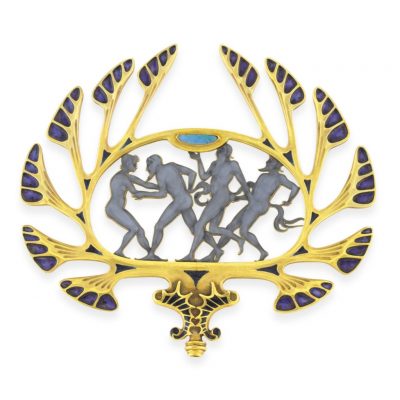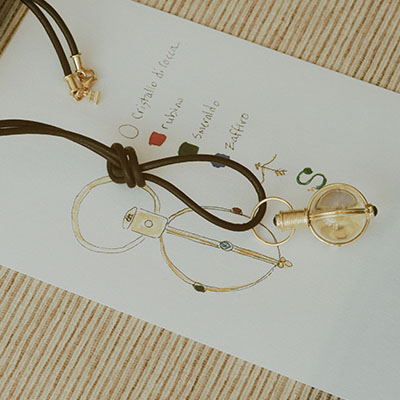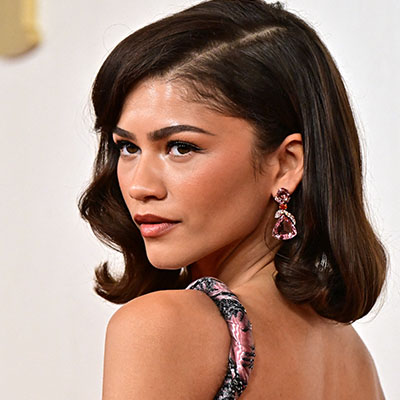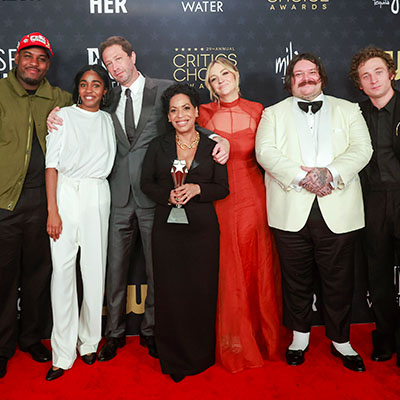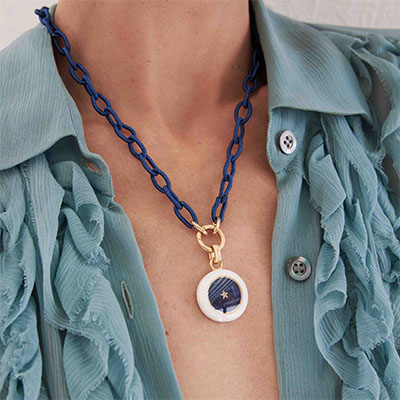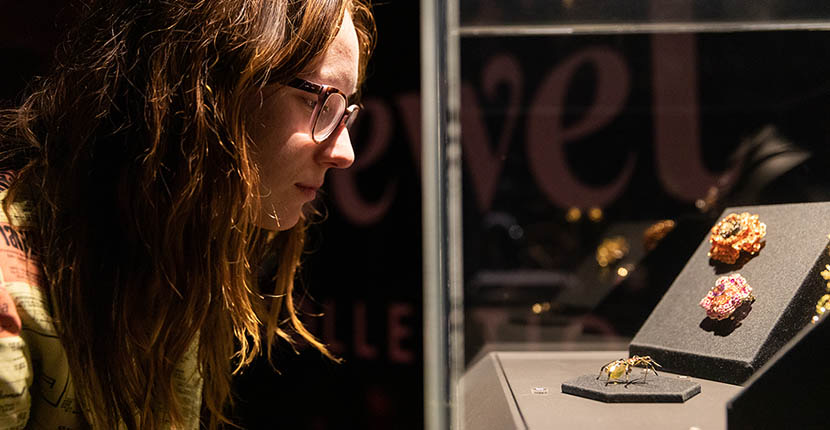
A visitor to the Natural History Museum in Los Angeles looking at Paula Crevoshay's work in the 'Art of the Jewel' exhibit. Photo courtesy
Books & Exhibitions
‘The Art of The Jewel’ Exhibit in Los Angeles
Paula Crevoshay’s creations shine alongside gems at the Natural History Museum
“Paula Creovshay tells gemstone stories with her jewelry,” explains Dr. Aaron Celestian, curator at the Natural History Museum of Los Angeles. “A Crevoshay piece stands out because of her careful placement of each stone, either complementing or contrasting with the color of its surroundings, and her insightful use of phenomena like refraction and play of color allows us to see new colors emerge from gems that we might not otherwise notice.”
The designer’s use of gems and minerals made her the perfect subject for an exhibition illustrating some of the Earth’s processes as well as the creativity that happens with the material when it is cut by lapidaries and set in her imaginative jewels. I took a tour around the Art of the Jewel: The Creovshay Collection with Dr. Celestian who elucidated the scientific angle of some of the stones and minerals on display among over 50 pieces of jewelry from the designer. He also shared several interesting statistics such as “Out of approximately 5,000 minerals on Earth, only about 300 are considered gems—minerals attractive, precious, and durable enough to be used in jewelry.”
Following are excerpts of my conversation with Dr. Celestian illustrated with Christopher Chavez’s photos from the book Art of the Jewel by Paula Crevoshay and Martin Bell. The last day of the exhibition is May 12, 2019. The book is available on Amazon now.
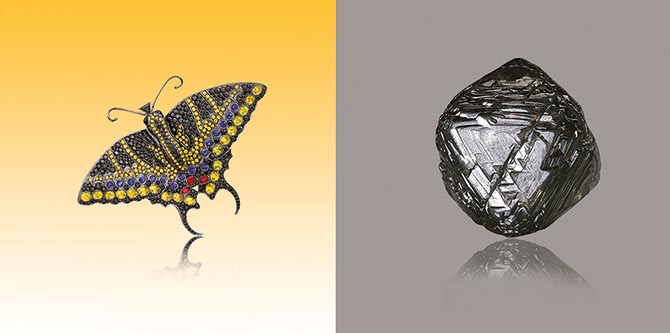
Paula Crevoshay black diamond Swallowtail brooch accented with yellow sapphires, Montana sapphires, amethyst and spinel and a black diamond rough. Photo by Christopher Chavez from the ‘Art of the Jewel’ book.
Tell me about the connection between black diamonds and graphite?
When diamonds are erupted out of the Kimberlite pipes and volcanos, they come from maybe 200 miles below the earth. Sometimes the volcanic eruption stops along the way and there are still geochemical processes that are happening. Diamond has been removed from its pressure stabilized situation. It has been pushed up. It’s still very hot but the pressure has been reduced and it is forming into a very different mineral called graphite. Black diamonds typically have a lot of graphite in them. They can have other deep mantle minerals in them as well.
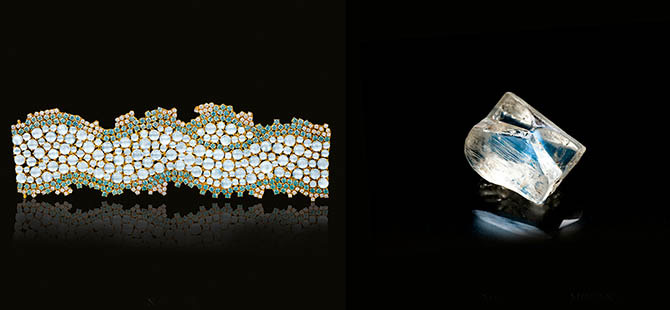
Paula Crevoshay Nam Lai moonstone, zircon and diamond bracelet bracelet and a rough moonstone. Photo by Christopher Chavez from the ‘Art of the Jewel’ book.
What are some of the interesting qualities of moonstones?
There is an optical phenomenon call adularescence in moonstones. The rough moonstone in the case with Paula’s bracelet was placed in a specific orientation so that if you stand in one spot you don’t see the bright adularescence, but when you move around it just visually explodes. You see the plays of color the moonstones have. The cabochons in Paula’s bracelet have a cat’s eye effect. They are faceted in a way to reflect the light just right so it looks like it is sparkling all the time.
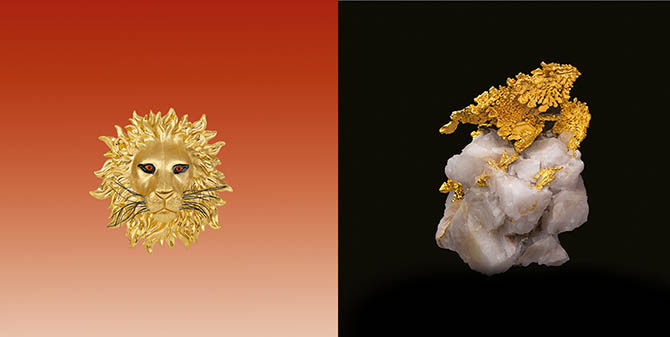
Paula Crevoshay gold lion brooch accented with amber and black diamonds and a specimen of gold on quartz from the Colorado Mine in Mariposa County, California. Photo by Christopher Chavez from the ‘Art of the Jewel’ book
What exactly is a mineral?
Minerals are naturally occurring, inorganic—nonliving—solids made of chemical elements that have bonded together in a specific pattern. We have a lot of gold in the museum because it relates to the California Gold Rush. It is the mineral that appears most often in Paula’s work. All of the gold she uses is 18 Karat.
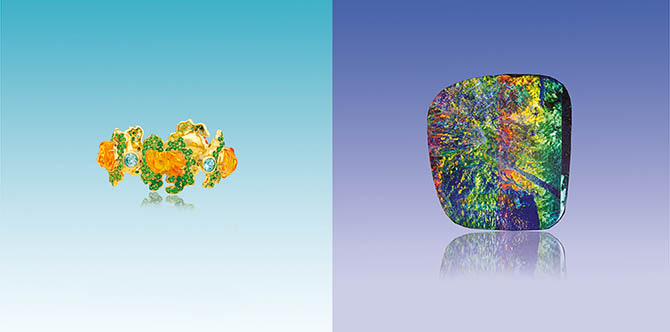
Paula Creovshay Queen’s Tiye’s Amulet Bracelet set with Mexican fire opal, zircon and tsavorite and a Boulder Opal. Photo by Christopher Chavez from the ‘Art of the Jewel’ book
What is the role of water with gems?
Whether running through the ground or falling from the sky, water picks up different chemical elements and leaves them behind in mineral form when it cools or evaporates. Some minerals—like the opals displayed here—even contain small amounts of water. Paula’s bracelet is set with bright orange Mexican fire opals that have a play of the color green inside. The tsavorites on the jewel enhance the play of green.
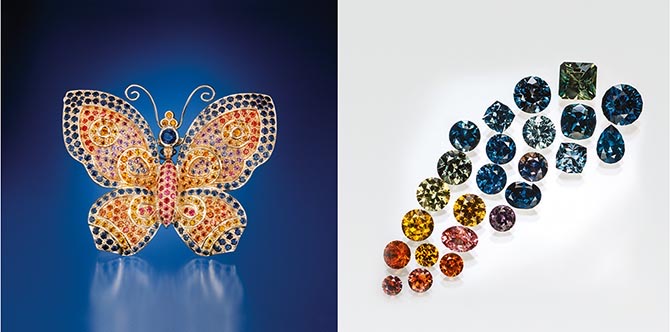
Paula Crevoshay’s Conchita Butterfly set with Montana sapphires and an array of Montana sapphires. Photo by Christopher Chavez from the ‘Art of the Jewel’ book
Where do the sapphires come from in the Conchita butterfly?
The jewel is set entirely Montana with sapphires. It was made in 2007 and commissioned by the Smithsonian. Now it’s part of that museum’s permanent gem collection. Montana sapphire was discovered by gold miners curious about the small, colored stones clogging up their equipment. It’s known for its rainbow array of colors—the rarest of which is pink. It took Paula several years to gather enough Montana sapphires to create the pink flower on display with the butterfly.
Related Stories:
The Amazing Work of Jewelry’s Designing Women
Take A Deep Dive Into Paraíba Tourmalines
Adventures in Emeralds With Judy Geib
Get a gem in your mailbox SIGN UP FOR THE ADVENTURINE NEWSLETTER
